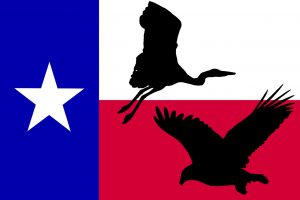November ushers in the winter birding season in Texas.
It has some of the most pleasant weather of the year, and the increasing diversity of hawks, sparrows, and ducks makes this great time to be outside looking for birds.
Endangered birds like Whooping Cranes can only be seen in Texas during winter, and November is their big arrival month.
To the south, tropical rarities can wander up to the southern tip of Texas, like Northern Jacana, Rose-throated Becard, or Hook-billed Kite.
If you’re not targeting a single species, then head to one of the hotspots below for a guaranteed productive several hours of birding.
The Top November Locations
The Best November Texas Birding Hotspots Include:
- Aransas NWR – Corpus Christi
- John Bunker Sands Wetlands – Dallas
- Hagerman NWR – Dallas
- Village Creek Drying Beds – Dallas
- Hornsby Bend Bird Observatory – Austin
- Mitchell Lake Audubon Center – San Antonio
- Brazos Bend State Park – Houston
- Anahuac NWR – Houston
- Estero Llano Grande State Park – McAllen
- Santa Ana NWR – McAllen
If each area was only allowed one recommendation, these would be the top choices:
Dallas: Hagerman NWR
Houston: Brazos Bend State Park
Austin: Hornsby Bend
San Antonio: Mitchell Lake
Corpus Christi: Aransas NWR
McAllen: Santa Ana NWR
Aransas National Wildlife Refuge
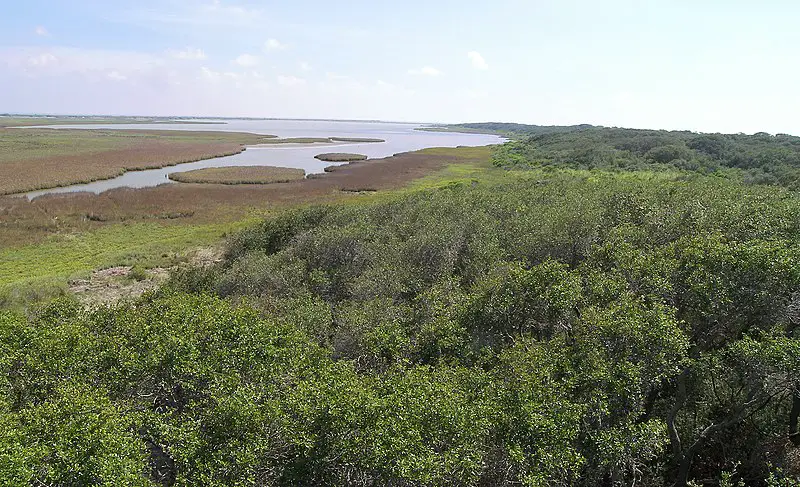
Entrance: $3
Located on the central Texas coast, this refuge is most famous for its endangered Whooping Cranes. It’s also great for seeing a mix of shorebirds, ducks, raptors, and a few wintering warblers.
If Whooping Cranes are your target, the best spots to see them are along Heron Flats trail, and from the observation tower.
Check out Where to see Whooping Cranes for more details on how to find and see these iconic birds.
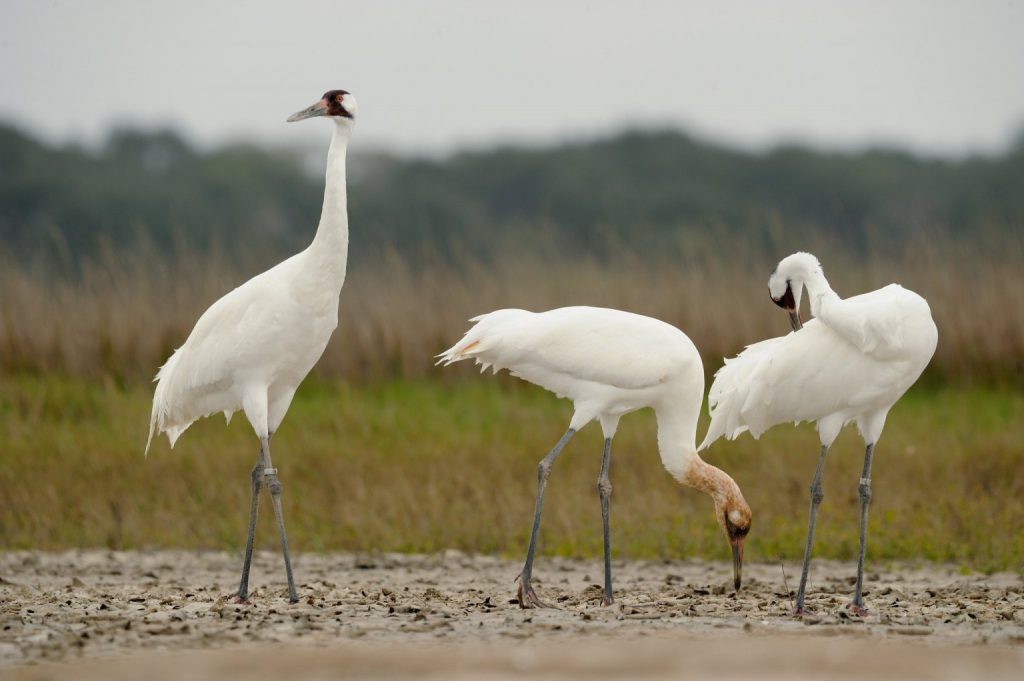
This refuge has a mix of open coastline, large marshy patches , and several oak mottes that attract woodland species. Multiple trails let you access all habitat types, and most branch off the main road so accessing them is easy.
You really don’t have to do much hiking here if that’s your preference. You’ll see plenty simply by standing in a good spot and watching everything that flies and swims by.
Birds to Look For
- Snow Goose
- Ross’s Goose
- Greater White-fronted Goose
- Mottled Duck
- Greater Scaup
- Long-tailed Duck (uncommon)
- Red-breasted Merganser
- Least Grebe
- Horned Grebe
- Sandhill Crane
- Whooping Crane
- American Avocet
- American Oystercatcher
- Common Loon
- Anhinga
- American Bittern
- White-tailed Hawk
- Peregrine Falcon
- Great Kiskadee
- Vermillion Flycatcher
- Sedge Wren
- Gray Catbird
- Boat-tailed Grackle
- Black-and-White Warbler
John Bunker Sands Wetlands Center

Entrance: $5
Closed Sunday & Monday
This wetlands center is good for wintering ducks, sparrows, and the nesting pair of Bald Eagles that have returned each year since 2011.
While there’s plenty of birds to keep birders busy for a morning, this location is more of an honorable mention on this list, rather than truly one of the best in the state. The eagles are the real showstoppers here.
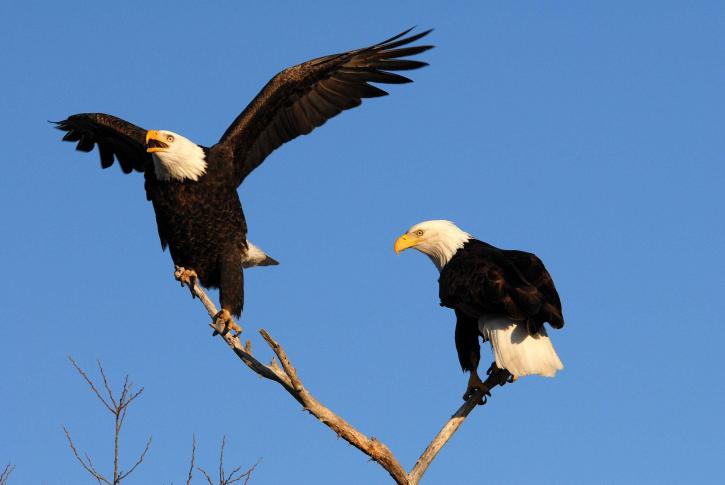
The male and female Bald Eagles typically return by mid-October and quickly get to reforming the massive nest they reuse each year. Just ask the staff and they’ll quickly point it out to you. It’s up on one of the metal powerline support structures.
During November you can sometimes see the eagles flying in with nesting material as they reinforce the nest from last year. They can also be seen flying overhead and patroling the area.
If you want a good spot for Bald Eagle south of Dallas, plus an enjoyable boardwalk over the wetlands, this is your spot.
Species to Look For
- Snow Goose
- Ross’s Goose
- Greater White-fronted Goose
- Virginia Rail
- Long-billed Dowitcher
- Tricolored Heron
- Northern Harrier
- Bald Eagle
- Merlin
- Fox Sparrow
- Brewer’s Blackbird
Hagerman National Wildlife Refuge

Entrance: Free
Also great for Bald Eagles, Hagerman is one of the best inland birding locations in the whole state. November can be particularly good because of the impressive geese numbers.
Located at the northern edge of the state, almost directly north of Dallas, this wildlife refuge borders Lake Texoma. The abundant water attracts ducks, herons, and a few Bald Eagles. Water levels can vary substantially, but when they’re just right the ducks can number over a thousand and be viewed at fairly close range.
Refuge staff grow wheat in open areas along the main drive path, and cut it but don’t harvest it. This leaves an abundance of food waiting for the Snow and Ross’s Geese as they arrive in full force during November. Watching them feed by the thousands at close range is often the most memorable and enjoyable experience birders get from this refuge.

In addition to the marshy lake edges, an abundance of woodland habitat around the lake completes the birding experience. It’s a great place to see woodpeckers, nuthatches, creepers, and sparrows. Wooded edges with grasses and ragweed can be good for Purple Finch.
Do your best to arrive at sunrise, and you’ll be rewarded with a refuge exploding in bird activity.
Bring water and snacks, it’s easy to see lunchtime come and go while still wanting to stay longer because the birding is just so good.
Birds to Look For:
- Snow Goose
- Ross’s Goose
- Greater White-fronted Goose
- Cackling Goose
- Canada Goose
- Common Goldeneye
- Hooded Merganser
- Red-breasted Merganser
- Horned Grebe
- Eared Grebe
- Greater Roadrunner
- American Avocet
- Black-bellied Plover
- Dunlin
- Long-billed Dowitcher
- Bonaparte’s Gull
- Red-headed Woodpecker
- Hairy Woodpecker
- Merlin
- Golden-crowned Kinglet
- White-breasted Nuthatch
- Brown Creeper
- Winter Wren
- Brown Thrasher
- Purple Finch
- LeConte’s Sparrow
- Eastern Towhee
- Rusty Blackbird
Village Creek Drying Beds

Entrance: Free
Here’s another good wetlands surrounded by woodland that’s great for ducks.
Unlike Hagerman, this proeprty is located right in the middle of DFW, in Arlington. While not as grand and expansive as Hagerman, it’s much closer for most people.
The property is the result of a nearby sewage treatment plant. The clean, treated water gets pumped out into holding ponds, which make for great wildlife habitat.
The entry road is heavily wooded, with wetlands partially visible from the road. It’s a great place to go slow and look for small song birds up high, while watching for Wood Ducks and Blue-winged Teal swimming under the trees.
The road dead ends at a small parking lot, at which point you have to walk the rest of the property. Wear sturdy shoes and pants, as the ground is sometimes uneven with tall grass.
Although it’s open to the general public, the hours can be weird as the front gate is often locked by around 4:30pm. Plan on birding here during morning hours if at all possible, otherwise you’ll be rushed.
Bring a scope if you can, it’ll make scanning the ponds much more enjoyable.
Birds to Look For
- Black-bellied Whistling Duck
- Greater Scaup (uncommon)
- Least Grebe
- Eared Grebe
- Black-necked Stilt
- American Avocet
- Long-billed Dowithcher
- Wilson’s Phalarope (uncommon)
- Bonaparte’s Gull
- Franklin’s Gull
- American Bittern (uncommon)
- Merlin (uncommon)
- Vermillion Flycatcher
- Tree Swallow
- Sedge Wren
- Marsh Wren
- LeConte’s Sparrow (uncommon)
- Swamp Sparrow
- Rusty Blackbird
- Palm Warbler
Hornsby Bend Bird Observatory

Entrance: Free
Must briefly check in at the security gate as you drive in. Just tell them you’re there to look at the birds, they’ll let you in.
Located in southeast Austin, this wastewater treatment facility along the Colorado River is one of the best birding sites in central Texas.
It features three main ponds, one heavily wooded pond, and several small drying beds that can be active when shallow water is present. These are all highly attractive to waterfowl and shorebirds.
The Colorado River bends around the property, which funnels many birds in the region through this property. Woodland habitat is abundant and easily accessible between the river and ponds.
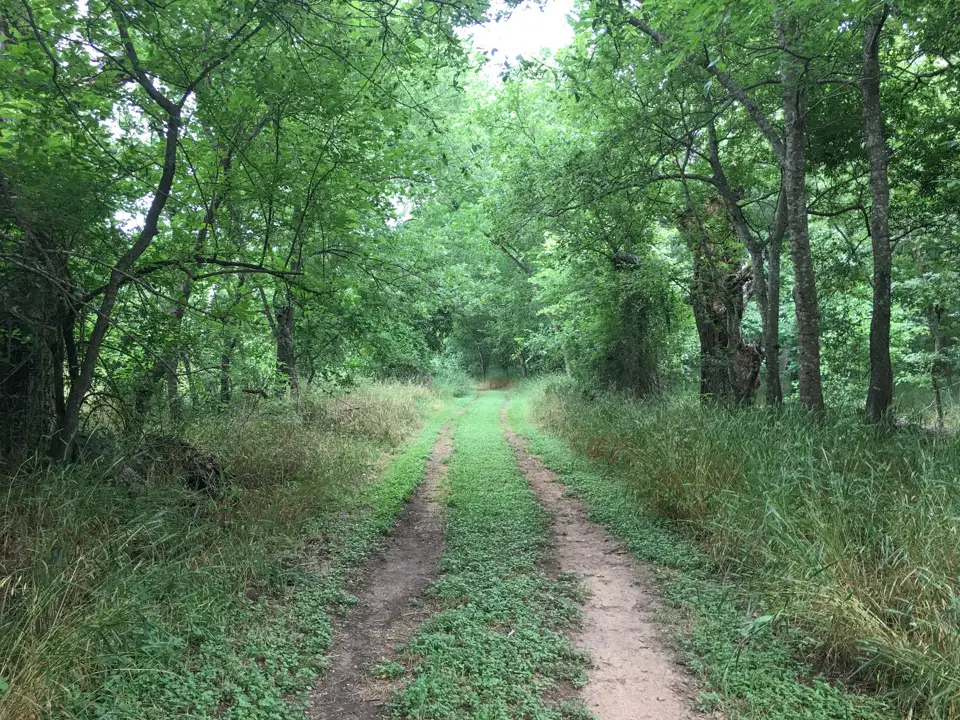
Add the small open grassland near the entrance, and you’ve got a great mixture of habitats all in one property.
Narrow roads allow birders to drive between the holding ponds, easily scanning the water through your rolled down car windows. Ducks number in the hundreds, while shorebirds are easy to find along water edges and shallows.
On the back side of the ponds there’s a small parking area near a blind overlooking the water. This is an easy access point to the woodland trail, which gives you brief views of the Colorado River.
Hornsby is great because you can see plenty of birds without ever leaving your car, or you can do a little leisurely hiking and really tally up your species list.
Getting 50+ species in two hours is typical during morning hours for birders at an intermediate skill level.
Birds to Look For:
- 16+ duck species
- Surf Scoter (uncommon)
- Least Grebe
- Eared Grebe
- American Avocet
- Western Sandpiper
- Long-billed Dowitcher
- Solitary Sandpiper
- White-faced Ibis
- Northern Harrier
- Merlin
- Blue-headed Vireo
- Cave Swallow
- Golden-crowned Kinglet
- Rusty Blackbird
- Brewer’s Blackbird
- Nashville Warbler
- Pine Warbler
Mitchell Lake Audubon Center

Entrance: $5
Located on the south side of San Antonio, this is a phenomenal central Texas birding location. It features a native plant garden with walking trails behind the headquarters building, ponds with plenty of birds, shrubby south Texas woodland, and the edge of Mitchell Lake.
Birding here consists of easy walking on flat terrain, and slowly driving around the ponds and viewing birds from your car.
The property is located at the northern range of many south Texas species, so potential birds include Green Kingfisher, Long-billed Thrasher, Olive Sparrow, and Aububon’s Oriole.
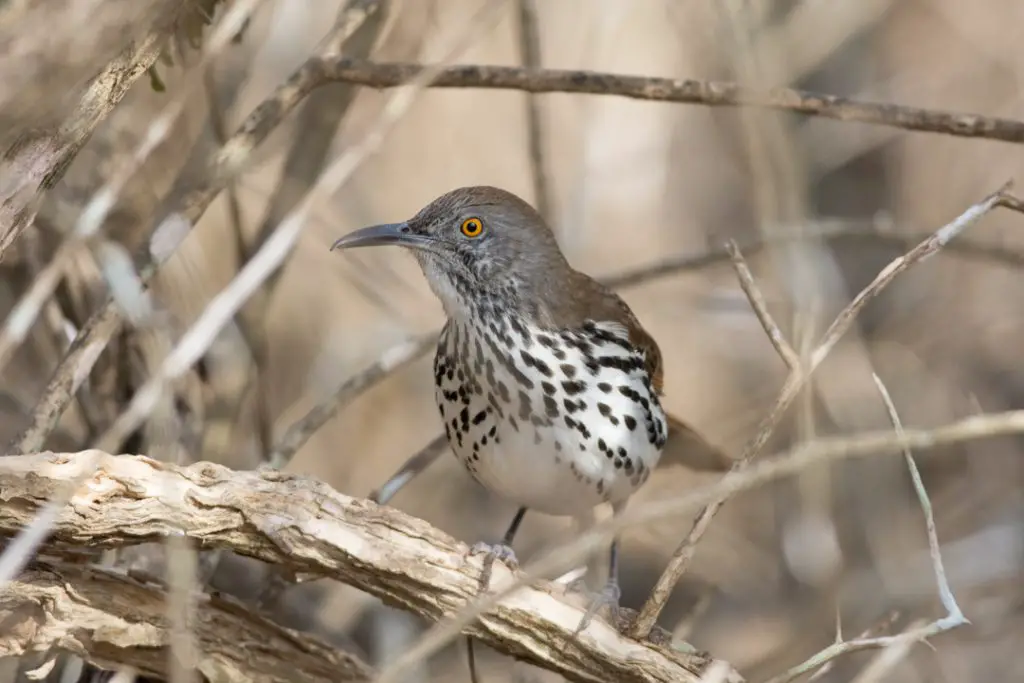
Shorebirds, herons and egrets, and other water loving birds like pelicans are all abundant one the back side of the property along the edge of the lake.
The best strategy here is:
1. Walk the native garden trails at the HQ building.
2. Pause for 20 – 30 minutes at Bird Pond at the middle of the property.
3. Slowly drive along the ponds at the back side of the property, which lead you to a back arm of the lake.
Hitting 50 to 60 species in a single morning isn’t difficult, and seeing above 70 is possible for skilled birders. Even if you’re on the far side of San Antonio, this location is worth the drive.
Note that the property is closed on Mondays, and often closes by 3pm all other days.
Birds to Look For
- Cinnamon Teal
- Surf Scoter (uncommon)
- Least Grebe
- Eared Grebe
- Greater Roadrunner
- Black-necked Stilt
- American Avocet
- Stilt Sandpiper
- Western Sandpiper
- Wilson’s Phalarope
- Solitary Sandpiper
- Bonaparte’s Gull
- Anhinga
- American White Pelican
- Black-crowned Night Heron
- White Ibis
- White-faced Ibis
- Roseate Spoonbill
- Osprey
- Harris’s Hawk
- Green Kingfisher (uncommon)
- Say’s Phoebe
- Couch’s Kingbird
- Verdin
- Curve-billed Thrasher
- Long-billed Thrasher
- Olive Sparrow
- Audubon’s Oriole (uncommon)
- Nashville Warbler
- Pyrrhuloxia
Brazos Bend State Park
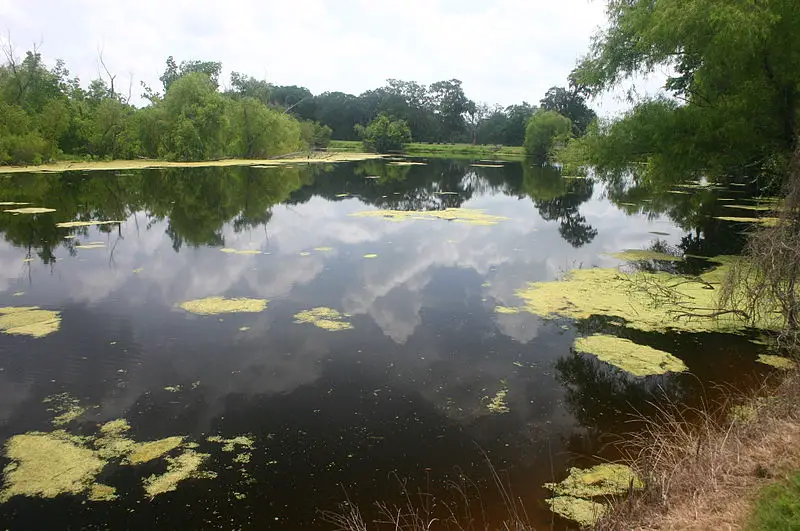
Entrance: $7
This state park has a good mix of open water, wetlands, and woodland habitat. It allows you to get close up views of ducks, herons, ibises, and spoonbills. It’s also know for it’s alligators, which sometimes sun themselves right along walking trails.
The wetlands areas can be good for American Bittern in November. Watch for them hunting frogs and fish along the edges of cattails.
Occasionally 40 acre lake (the big lake near the headquarters) will get flyover Bald Eagles. Sandhill Cranes are another common flyover in the park.
Abundant large hardwoods are good for Pileated Woodpecker and Barred Owl. Sometimes the owls can be heard calling even during daylight hours.
Birding for about 2.5 hours here should yield around 50 species.
Birds to Look For
- Fulvous Whistling-Duck
- Least Grebe
- Sandhill Crane
- Anhinga
- American Bittern
- Roseate Spoonbill
- Northern Harrier
- Bald Eagle
- Barred Owl
- Vermillion Flycatcher
- Blue-headed Vireo
- Northern Rough-winged Swallow
- Tree Swallow
- Golden-crowned Kinglet
- Sedge Wren
- Marsh Wren
- Brown Thrasher
- LeConte’s Sparrow
- Boat-tailed Grackle
- Wilson’s Warbler
Anahuac National Wildlife Refuge
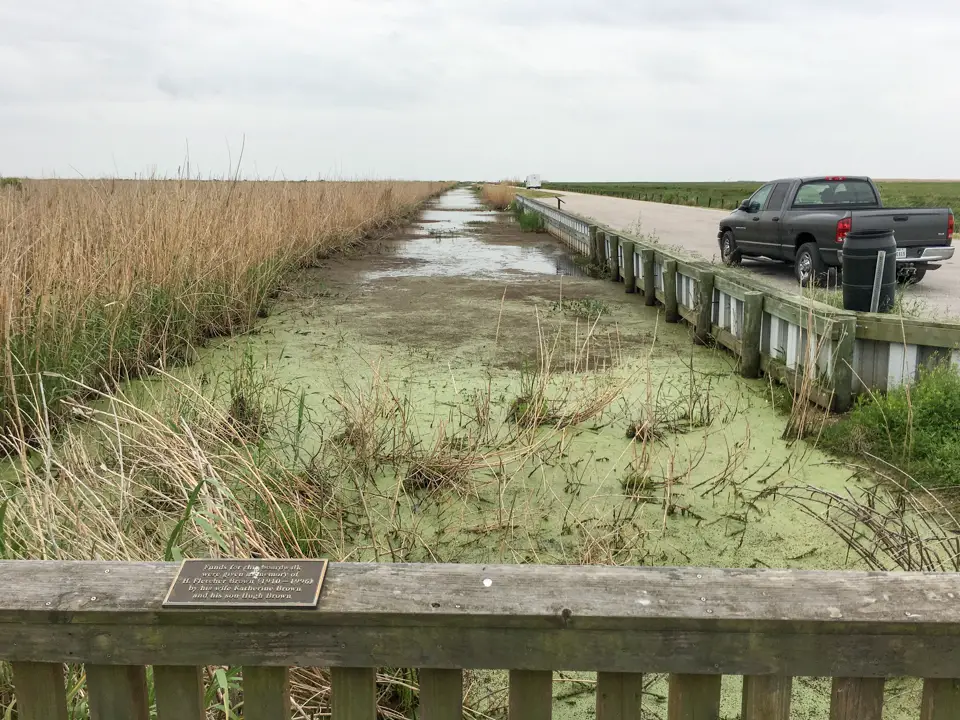
Entrance: Free
In terms of species count, Anahuac is easily one of the best bird watching locations in the state during November.
Many birders stay for at least 3 to 4 hours because there’s just so much to look at, and often leave with 50 to 60+ species on their list.
Lingering neotropic migrants are common here during November. Birds like Yellow-billed Cuckoo, Western Kingbird, Prairie Warbler, Indigo Bunting are uncommon but not unexpected. Especially at the beginning of the month.
When you visit, expect impressive numbers of ducks, along with plenty of herons, egrets, spoonbills, and other wetlands-loving birds. Shorebirds, gulls, and terns are also scattered throughout in healthy numbers.
Sparrows and wrens are abundant. Sedge Wrens and Marsh Wrens are seemingly everywhere, although you’ll hear them more than you see them.
The main spots to hit are Willow Trail by the headquarters building, and Shoveler Pond Loop. Willow Trail must be walked, but Shoveler Pond can be entirely birded from your car.
Frozen Point is a good spot to drive to if you want to see the back side of the refuge. It gives a view overlooking the bay where you might get lucky with a Red-breasted Merganser or Common Loon. Shorebirds can be seen as well.
The Skillern Tract to the east can be good, but is significantly smaller. You won’t miss much by skipping it.
Birds to Look For
- Fulvous Whistling-Duck
- Snow Goose
- Ross’s Goose
- Greater White-fronted Goose
- Cinnamon Teal
- Mottled Duck
- King Rail
- Sandhill Crane
- Black-bellied Plover
- Common Loon
- American White Pelican
- Brown Pelican
- American Bittern
- Glossy Ibis (uncommon)
- Osprey
- White-tailed Kite
- Bald Eagle
- White-tailed Hawk
- Merlin
- Peregrine Falcon
- Vermillion Flycatcher
- Sedge Wren
- Marsh Wren
- LeConte’s Sparrow
- Boat-tailed Grackle
- Palm Warbler
Estero Llano Grande State Park
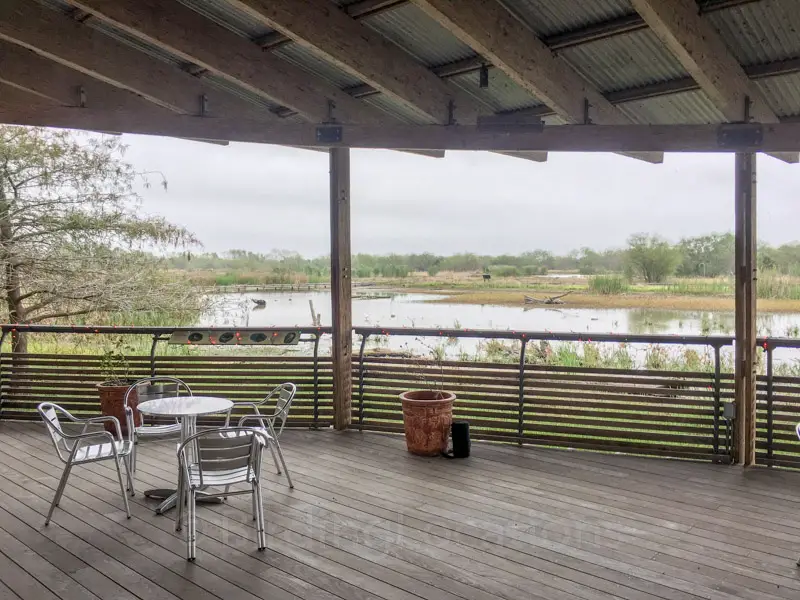
Entrance: $5
This small south Texas park packs a punch for its size. Birding here doesn’t require much hiking, but it’s a guaranteed good time with plenty to see.
The back of the headquarters building has a large covered wooden deck overlooking a small wetlands. It’s possible to pull up a chair here for 2 or 3 hours, and without visiting any other area of the park still walk away with 50 species.
South Texas specialties are as easy to see here as anywhere else. Plain Chachalacas and Green Jays will greet along the entrance path to the headquarters building, while Harris’s Hawk and Ringed Kingfisher can be seen while walking the property.
Rarities sometimes visit here during winter months. Rose-throated Becard makes appearances some winters in the tropical zone – the wooded western side of the park. Other documented rarities include Northern Jacana, Gray-crowned Yellowthroat, and Crimson-collared Grosbeak.
The free guided bird walks by park staff are excellent and highly recommended.
Birds to Look For
- Fulvous Whistling-Duck
- Cinnamon Teal
- Mottled Duck
- Plain Chachalaca
- Least Grebe
- White-tipped Dove
- Common Pauraque
- Ruby-throated Hummingbird
- Black-chinned Hummingbird
- Buff-bellied Hummingbird
- Sandhill Crane
- Stilt Sandpiper
- Long-billed Dowitcher
- Spotted Sandpiper
- Solitary Sandpiper
- Lesser Yellowlegs
- Wood Stork (uncommon)
- Anhinga
- American Bitter
- Glossy Ibis
- White-tailed Kite
- Harris’s Hawk
- White-tailed Hawk
- Gray Hawk
- Ringed Kingfisher
- Green Kingfisher
- Peregrine Falcon
- Northern Beardless-Tyrannulet
- Black Phoebe
- Vermillion Flycatcher
- Great Kiskadee
- Tropical Kingbird
- Couch’s Kingbird
- Green Jay
- Northern Rough-winged Swallow
- Tree Swallow
- Curve-billed Thrasher
- Long-billed Thrasher
- Clay-colored Thrush
- Olive Sparrow
- Hooded Oriole (uncommon)
- Altamira Oriole
- Bronzed Cowbird
- Ovenbird
- Black-and-white Warbler
- Northern Parula
- Tropical Parula
- Yellow-throated Warbler
- Black-throated Green Warbler
- Wilson’s Warbler
- Indigo Bunting
Santa Ana National Wildlife Refuge

Nicknamed “The Crown Jewel of the National Wildlife Refuge System”, it’s difficult to not have a great time here as a birder and wildlife lover.
South Texas specialty species are easy to find here, and the diversity of habitat keeps things interesting.
Santa Ana is best enjoyed by hiking 2 to 3 miles in a morning. This will allow you to see dense south Texas scrub, wooded wetland, open grassland with ponds, and the hawkwatch tower all in one visit.
If raptors are high on your target list then Santa Ana should be your top destination. You’ll see hawks like Harris’s Hawk and Gray Hawk, and have a chance at White-tailed Hawk and Zone-tailed Hawk. Others are common like accipiters, Red-tailed and Red-shouldered Hawk, Northern Harrier, and Osprey.

This is the go-to spot for Hook-billed Kite in the United States. These kites are always rare, but are seen on and off during winter months at Santa Ana. Spending an hour or two atop the hawkwatch tower is often the best way to see them, although a heavy dose of luck is also required.
If this is your first visit, then the free guided bird walks are likely the best way to spend your time here. The guides are extremely knowledgeable about birds on the refuge, and often know roosting spots of Eastern Screech-Owls and Common Pauraques that they’ll show the group.
Birds to Look For
- Fulvous Whistling-Duck
- Greater White-fronted Goose
- Cinnamon Teal
- Mexican Duck
- Mottled Duck
- Least Grebe
- White-tipped Dove
- Groove-billed Ani
- Greater Roadrunner
- Common Pauraque
- Buff-bellied Hummingbird
- Long-billed Curlew
- Stilt Sandpiper
- Long-billed Dowitcher
- Solitary Sandpiper
- Anhinga
- American Bittern
- Osprey
- White-tailed Kite
- Hook-billed Kite (uncommon)
- Northern Harrier
- Harris’s Hawk
- White-tailed Hawk
- Gray Hawk
- Ringed Kingfisher
- Green Kingfisher
- Peregrine Falcon
- Northern Beardless-Tyrannulet
- Black Phoebe
- Vermillion Flycatcher
- Great Kiskadee
- Tropical Kingbird
- Couch’s Kingbird
- Green Jay
- Northern Rough-winged Swallow
- Tree Swallow
- Curve-billed Thrasher
- Long-billed Thrasher
- Clay-colored Thrush
- Olive Sparrow
- Altamira Oriole
- Bronzed Cowbird
- Black-and-White Warbler
- Nashville Warbler
- Black-throated Green Warbler
- Wilson’s Warbler
- Indigo Bunting
Need More Options?
If you’re looking for other good hotspots, or your area of Texas isn’t on this list, check out the Texas Hotspot Map.
Each hotspot on the map has a dedicated birding guide with photos. It will help you see more birds in less time, and enjoy some of the best birding Texas has to offer.


